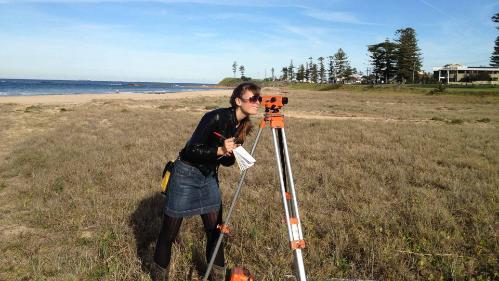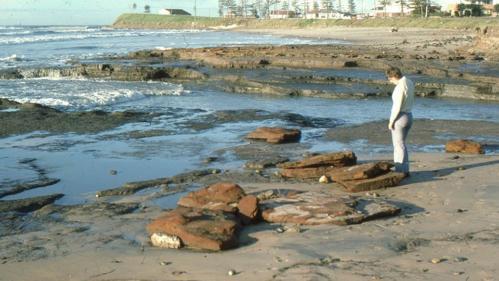July 18, 2019
New study puts old dates to rest
Mud buried below Bulli Beach clarifies the timing and extent of the last major sea-level rise, with implications for the future
Evidence of past sea levels is a critical piece of the puzzle in predicting how much sea level could rise in the future and its impact on coastal communities.
In Australia, four out of five people live within 50 kilometres of the cost, putting at risk millions of lives and billions of dollars of infrastructure based on NSW planning benchmarks of representing sea-level rises along the NSW coast of up to 40 centimetres by 2050 and up to 90 centimetres by 2100, relative to 1990 levels.
To better predict how sea level will change in the future, we need to look into the past.
“Features along our coasts preserve a record of previous sea levels that can be used to construct a history of change back through time, ” explains Dr Amy Dougherty, an Honorary Research Fellow at UOW’s School of Earth, Atmospheric and Life Sciences.

Evidence from around the world document the last major sea-level rise that occurred when glaciers melted rapidly between 21,000 and 7,000 years ago, pushing global sea surfaces from roughly 120 metres below current levels.
Along coasts located far from glaciers and ice sheets, such as in Australia, evidence from the end of this rapid rise can be preserved above present-day sea level by a relative “highstand”, a regional high-water mark of sort resulting from the land adjusting to the loss of ice and increase in water.
“Considerable research has been done on sea level in Australia, yet debate has continued about the timing and extent of a relative sea level highstand along the east coast,” Dr Dougherty said.
She has been working to clear up the debate around the East Coast highstand and is lead author of a new study addressing the oldest evidence of a highstand recorded around Australia and the world.
The data was collected from Bulli beaches in the late 1970s and has been used to show the relative sea-level highstand reached a maximum elevation of 1.8 metres above current sea levels 8,000 years ago.

Bulli Beach in the 1970s
The ages were established when a storm in 1978 stripped sand from the beach revealing an ancient estuarine mud, allowing a team of UOW scientist to radiocarbon date wood, charcoal, and shells collected from the surface.
Returning sand has long since covered the evidence, but given the importance of the site, Dr Dougherty teamed up with other researchers from several institutions, including Associate Professor Brian Jones – one of the authors of the original study from the 1970s– to revisit Bulli Beach in the hopes of re-examining the deposits.
Initial analysis used aerial photographs and remote sensing technology such as light detection and ranging (LiDAR) and ground penetrating radar (GPR), to map the elevation and lateral extent of the same deposits dated 40 years ago.
Then, sediment cores were collected as well as surface samples of wood and charcoal similar to those originally dated - courtesy of a significant storm in 2016 exposed the buried muds.
Co-author Professor Chris Turney, from UNSW, said: “Using more sophisticated sampling methods and analysis, we were able to date the relative highstand from 7,300 to 6,900 years before present, approximately a millennium more recently than previously reported.”
Dr Dougherty said the new dates are consistent with the age of the highstand extending as far north as the Gulf of Carpentaria and are synchronous with the timing of formation of the oldest beach ridges in Tasmania.
The refined younger age aligns also with major ice mass loss from Antarctic ice sheets and ongoing reduction in the Northern Hemisphere, supporting previous studies that suggest melting continued after rapid deglaciation ceased.
“Continued work along the Australian coast could provide a better idea of how the last 1-metre rise in sea level influenced the evolution of our coastlines, offering some insight on how best to prepare our communities and infrastructure for a similar increase within this century,” Dr Dougherty said.
The results of the study were published 17 July 2019 in the journal PLOS ONE.
ABOUT THE STUDY
The paper 'Redating the earliest evidence of the mid-Holocene relative sea-level highstand in Australia and implications for global sea-level rise' by Amy J. Dougherty, Zoë A. Thomas, Christopher Fogwill, Alan Hogg, Jonathan Palmer, Eleanor Rainsley, Alan N. Williams, Sean Ulm, Kerrylee Rogers, Brian G. Jones and Chris Turney is published in PLOS ONE.
:format(jpg)/prod01/channel_3/assets/media-centre/IMG_340234-999X562.jpg)